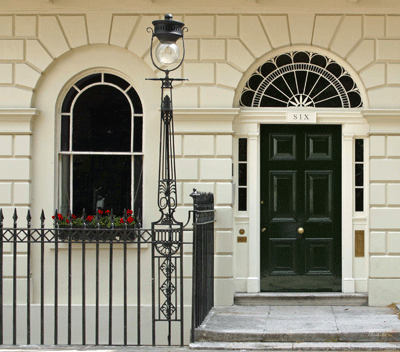Queen Victoria and the myth of black railings
The story goes that Queen Victoria ordered everything painted black after Prince Albert's death. Not so, says our architectural historian

In December 1861 the country was shocked by news of Prince Albert's sudden death. ‘Paint everything black' proclaimed a grief stricken Queen Victoria, and from that day to this, all railings in the land have been painted black. Well so the story goes - but it is just not true!
The story of Queen Victoria and black railings is a popular urban myth.

Black did not become the default colour for the decoration of railings until almost 100 years later - during the late 1950s. The reason? The development and availability of fast-drying alkyd resin paints.
Iron railings have always been painted to prevent them rusting. During the seventeenth and eighteenth-century, architectural metalwork was routinely painted grey, a cheap colour (lead white mixed with lamp black) referred to in contemporary accounts as ‘lead colour' or ‘iron colour'. Grey was the standard colour for all architectural metalwork until the early nineteenth century.
It was not until the manufacture of Chrome Green, that coloured railings became affordable. One of the earliest examples of this green, was applied to the Duke of Wellington's Apsely House railings - decorated during the 1820's.
After Albert's death, Queen Victoria wore black for the rest of her life and her staff were forced to wear mourning armbands until 1869.
An extensive survey carried out by English Heritage of all the architectural elements within the grounds of Osborne House (Queen Victoria's personal retreat on the Isle of Wight), failed to find any evidence at all of black railings.
Exquisite houses, the beauty of Nature, and how to get the most from your life, straight to your inbox.
* Subscribe to Country Life and save over £50 a year

Cross section of a paint sample showing the different layers of paint
Before the Clean Air Act of 1956, the high levels of city pollution meant that green paint quickly became discoloured. As these railings were redecorated throughout the nineteenth and early twentieth century, the shade of green paint applied becomes progressively darker. A preference for dark coloured railings seems to have developed. But pure black paint was not applied to railings, especially in public places, for one important technical reason - black paint took a very long time to dry.
Painters and decorators were anxious to avoid public anger by staining their clothes with slow drying black paint. The addition of pigments such as umber or chrome green would speed up the drying time of the paint considerably. The colours applied to railings in the late 19th century were called bottle-green, brown-green, black-green - but certainly not black.
It was not until the late 1950s, that UK painters and decorators had access to the new fast drying black alkyd-resin gloss paints, that railings were to be routinely painted black. And so the urban landscape turned glossy black - and very smart it is too.
But we want our modern preference for black railings, and our imagined idea of our pre-WWII cities to co-exist and so the Queen Victoria and the Myth of the Black Railings was invented. I do not expect that this article will lessen the power of the myth, or make the slightest impression on its acceptance as universal truth - and what does it matter anyway? Who wants to be the one to spoil a good story; it would be like killing-off Santa Claus or the Tooth Fairy...
Helen Hughes is architectural historian and an ICON accredited conservator-restorer. Helen runs her own consultancy - Historic Interiors Research & Conservation (HIRC) which aims to help the owners and managers of historic interiors understand the properties in their care, enjoy the insights they provide about their past, and make informed decisions about their future.

This is an article from ProjectBook which provides a wide range of information for the conservation, restoration, care and repair of period and listed buildings. Helen Hughes is a member of the Heritage Register which contains over 500 vetted craftsmen, contractors and consultants from all over the UK. Updated daily with new content, the website features the heritage register, a products directory, informative articles, current news, events and more. For more information, visit www.projectbook.co.uk.
Country Life is unlike any other magazine: the only glossy weekly on the newsstand and the only magazine that has been guest-edited by His Majesty The King not once, but twice. It is a celebration of modern rural life and all its diverse joys and pleasures — that was first published in Queen Victoria's Diamond Jubilee year. Our eclectic mixture of witty and informative content — from the most up-to-date property news and commentary and a coveted glimpse inside some of the UK's best houses and gardens, to gardening, the arts and interior design, written by experts in their field — still cannot be found in print or online, anywhere else.

